Types of Texas Oak Trees (With Pictures) – Identification Guide
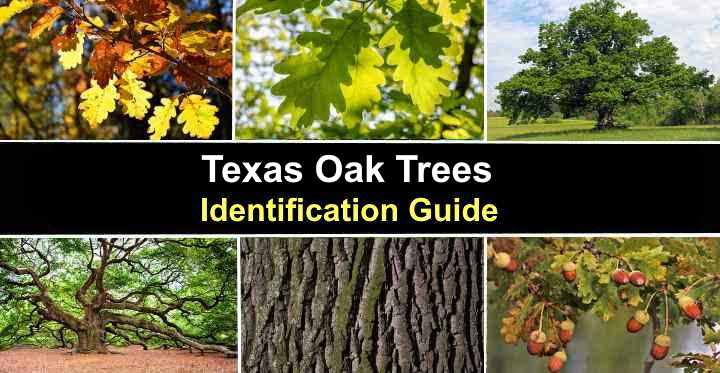
Oak trees in Texas are a common landscape feature. Texas oak trees are not only important shade trees that offer protection from the hot sun and arid climate. But oak trees are also a food source for local wildlife, providing abundant acorns in late summer and the fall. Many varieties of oak trees thrive in Texas, all the way from Amarillo in the north and south to Dallas, Houston, and San Antonio.
Identifying species of oak in the landscape is usually done by looking at the leaves, size of the tree, and type of acorns. And there are differences between Texas red oak trees, white oaks, and live oak trees. For example, although the Texas red oak (Quercus buckleyi) is the most common in the Lone Star State, several others thrive in the south.
This article is an identification guide to the wide varieties of native oak trees that grow in Texas. Descriptions and pictures of oak tree leaves, acorns, and bark will help identify these majestic deciduous trees in the landscape.
Texas Oak Tree Facts
Oak trees native to Texas are a group of broadleaf deciduous trees in the genus Quercus and the beech family Fagaceae. Oak trees produce acorns and typically have lobed leaves with pointed lobes or rounded ones. Texas oak trees are suitable for growing in USDA zones 6 through 9.
Types of Texas Oak Trees (With Pictures)
There are 90 varieties of oak trees native to North America. From those, several are well-suited to the unique climate of Texas. They must withstand cold, sometimes freezing winters in the Panhandle but also tolerate the heat and dry climates of southern Texas.
Let’s look in detail at 16 varieties of oak trees that thrive in the largest state in the US.
Texas Red Oak (Quercus buckleyi)

Texas red oak (Quercus buckleyi) young trees. Right image: autumn foliage
The Texas red oak tree is native to Central Texas and the area west of San Antonio. The medium to large-sized deciduous tree is identified by its deeply lobed green leaves with bristle-tipped ends. The Texas oak has a rounded crown, reddish-brown acorns, and dark gray to black bark.

Texas red oak leaves
Texas red oak trees grow 30 to 50 ft. (9 – 15 m) tall; however, they can grow taller on fertile land. The flowering oak tree thrives in full sun and is a relatively drought-tolerant tree when established. It is cold-hardy in USDA zones 6 to 11.
Also called Buckley oak and Spanish oak, Texas red oak tree acorns are egg-shaped nuts that measure 0.5” (1.3 cm). The acorns emerge green and become brown as they mature in 18 months.
Texas oak tree bark: Texas red oak tree bark is gray to black and has deep fissures and ridges.
Texas oak tree leaves: Texas red oak tree leaves have five to seven bristle-tipped lobes. They measure 3” to 5” (7.5 – 13 mm) long. The green leaves turn deep red shades in the fall.
Nuttall’s Oak Tree (Quercus texana)
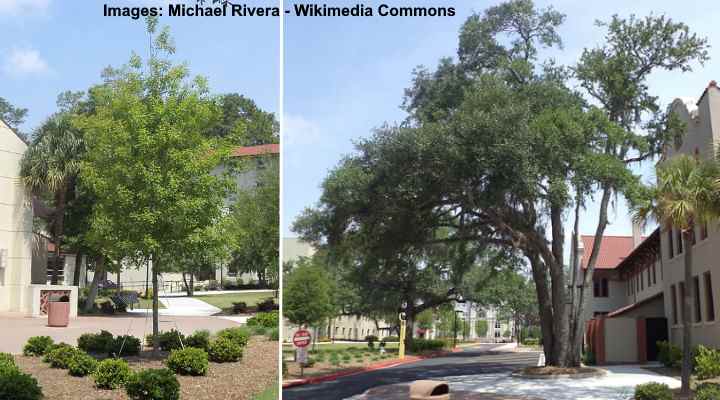
Nuttall’s oak (Quercus texana) young and mature trees
Nuttall’s oak is a large, fast-growing acorn tree native to eastern Texas. This species of oak tree is identified by its dark-green, sharply-pointed lobed leaves, oval to oblong brown acorns with scaly caps, and yellowish-green flowers. Its bark is charcoal gray and becomes scaly as the tree matures.
Nuttall’s oak tree is a species of red oak growing 50 to 80 ft. (15 – 24 m) tall. This Texas oak variety grows in USDA zones 6 to 9 and thrives in full sun and medium, well-drained soil. It also features a wide, spreading, rounded crown.
The Nuttall’s oak (Quercus texana) is easily confused with the Texas red oak (Quercus buckleyi) as the botanical names sometimes get mixed up. Therefore, the Nuttall oak is sometimes called the Texas oak tree.
Acorns on the Nuttall’s oak are oblong and measure 0.75” to 1.25” (2 – 3 cm) long, and the scaly cap covers about one-third of the dark brown nut.
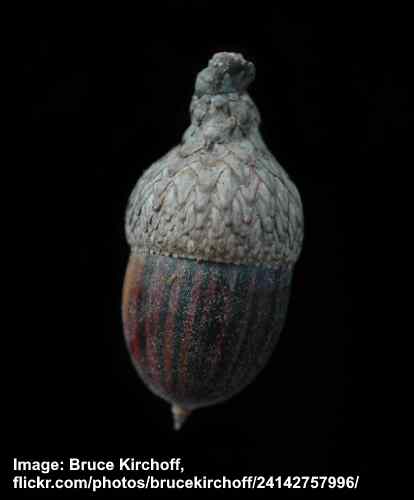
Nuttall’s oak acorn
Texas oak tree bark: Nuttall’s oak tree bark is brownish-gray to black and develops scaly plates.
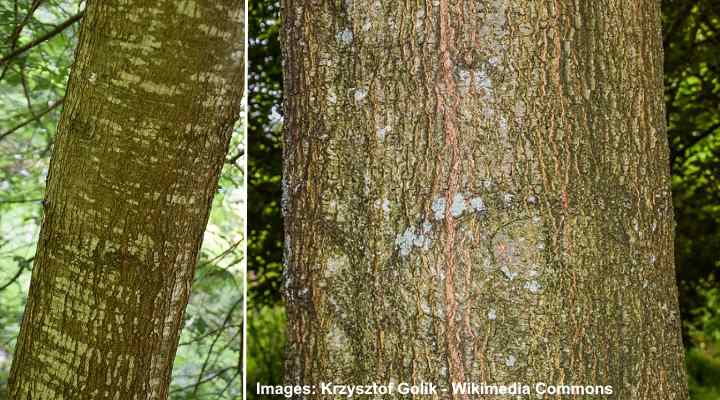
Nuttall’s oak bark
Texas oak tree leaves: Nuttall’s oak tree leaves have five to seven pointed lobes, and they measure 4” to 6” (10 – 15 cm) long. The fall foliage color is deep red.
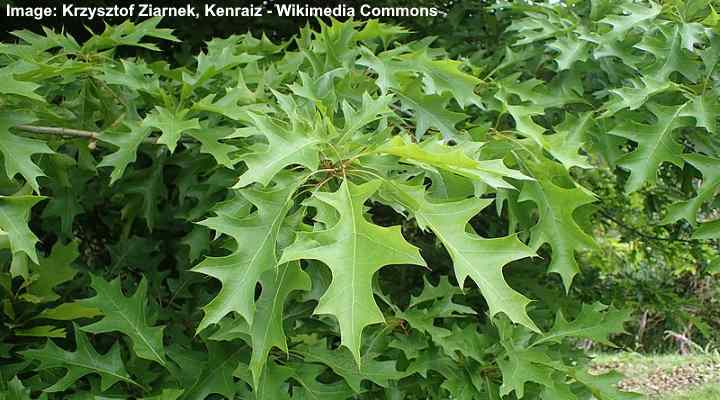
Nuttall’s oak leaves
Southern Live Oak Tree (Quercus virginiana)
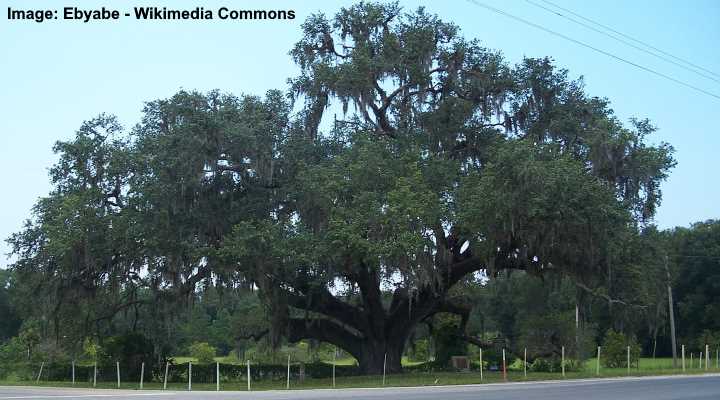
Southern live oak tree (Quercus virginiana)
The southern live oak is a large evergreen oak tree with a wide-spreading, rounded crown covered in leathery leaves. Common in Central and Southern Texas, this live oak tree species has smooth-edged leaves with fuzzy undersides, dark brown to black egg-shaped acorns measuring 1” (2.5 cm) long, and reddish-brown bark that becomes black and scaly.
The Southern live oak tree blooms in spring and produces clusters of drooping yellow-green male flowers called catkins. They are inconspicuous and don’t add any ornamental value to the tree. The female flowers are green to reddish short spikes.
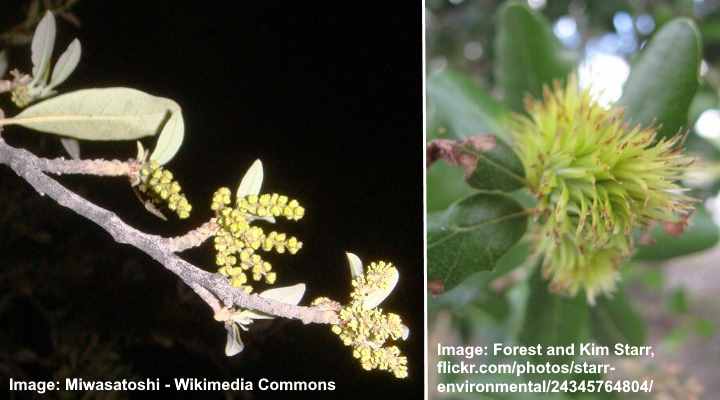
Southern live oak tree male flowers (left) and female flowers (right)
The southern live oak tree is a fabulous shade tree for warm climates. The oak tree grows 40 to 80 ft. (12 – 24 m) tall and has an oval crown 100 ft. (30 m) wide. The oak tree is suitable for growing in Florida or Texas in full sun and USDA zones 8 to 10.
Texas oak tree bark: Southern live oak tree bark is dark brown and has vertical deep furrows creating bumpy ridges.
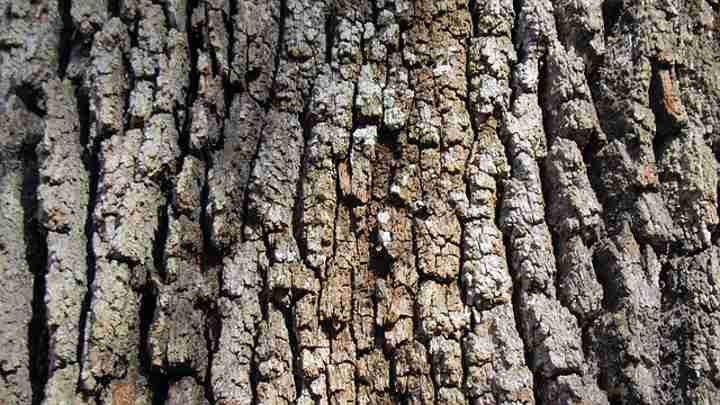
Southern live oak tree bark
Texas oak tree leaves: Southern oak tree’s leaves are oblong, elliptical, glossy green leaves with a leathery texture. The oak leaves have a shiny upper surface and fine, grayish hairs on the underside. They measure 2” to 5” (5 – 13 cm) long without the distinct lobes of white or red oak trees.
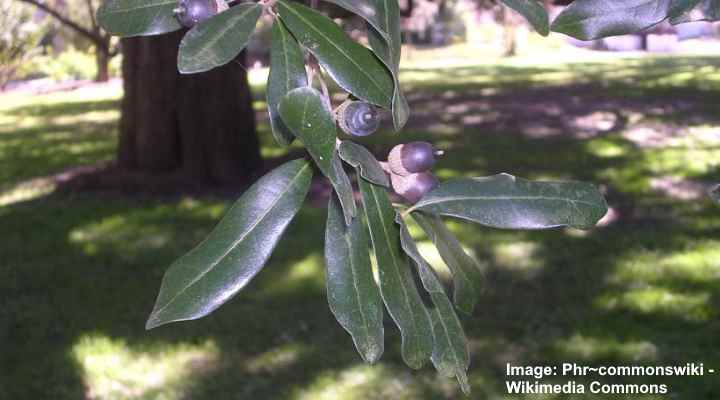
Southern live oak tree leaves and acorns
Mexican White Oak Tree (Quercus polymorpha)
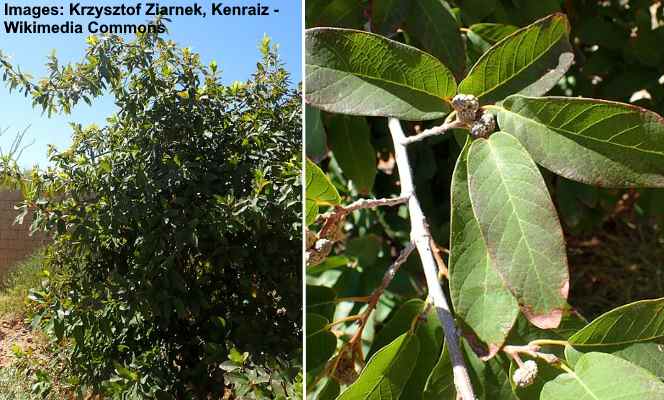
Mexican white oak (Quercus polymorpha) young tree and leaves
The Mexican white oak is a deciduous oak tree that grows in southern and western Texas but is native to Central and South America. The medium-sized ornamental oak tree has elliptical leaves, barrel-shaped acorns, and light gray bark.
The Mexican white oak — also called Monterrey oak or netleaf oak — grows well in USDA zones 7 to 10 in full sun and well-drained soils. The native oak grows 40 to 70 ft. (12 – 21 m) tall and has a broad, rounded crown.
Acorns on the Mexican oak tree are stumpy, brown oval nuts that measure 1” (2.5 cm) long. The warty cap covers about half of the acorn.
Texas oak tree bark: The Mexican tree bark is light to dark gray and develops shallow fissures on mature trees.
Texas oak tree leaves: The Mexican oak tree leaves are elliptical or egg-shaped. The oak leaves measure 2” to 5” (5 – 13 cm) long and turn yellow-brown in the fall.
Chinquapin Oak (Quercus muehlenbergii)
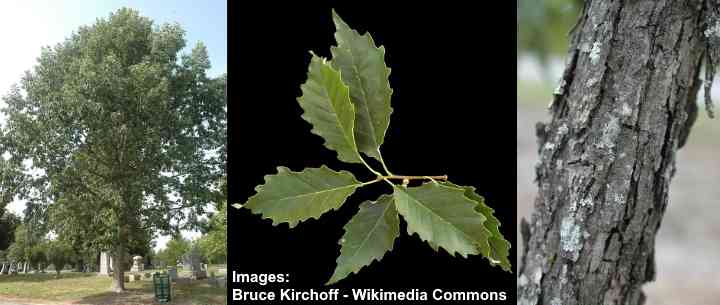
Chinquapin oak (Quercus muehlenbergii) tree, leaves and bark
The chinquapin oak tree (or chinkapin) is a species of white oak with leaves like a chestnut tree. Identifying features of the chinquapin oak are its copper-brown acorns, shiny lance-shaped, oblong leaves, and light gray bark. This oak tree is common throughout Texas.
The chinquapin oak tree grows 40 to 60 ft. (12 – 18 m) tall with a broad, rounded crown 70 ft. (21 m) wide. Suitable for growing as a shade tree in USDA zones 5 to 7, it thrives in full sun and dry to medium soils.
The acorns of the chinkapin oak tree are small with scaly caps and generally measure 0.75” (2 cm) long.
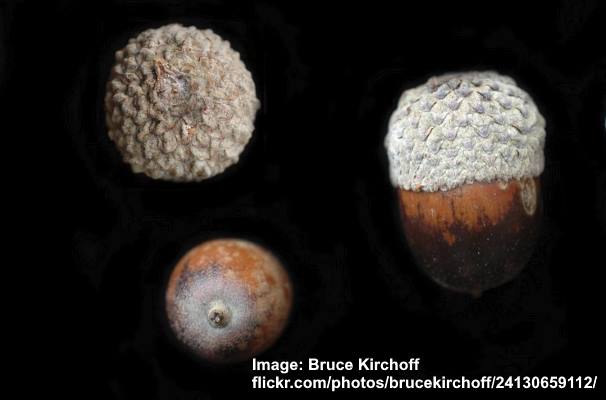
Chinquapin oak acorn
Texas oak tree bark: The chinquapin oak tree bark is light gray with irregular fissures giving it a rough texture.
Texas oak tree leaves: The chinquapin oak tree leaves are oblong with shallow pointed lobes along the margin. The glossy oak leaves measure 4” to 8” (10 – 20 cm) long and turn yellow or brown in the fall.
Bur Oak Tree (Quercus macrocarpa)
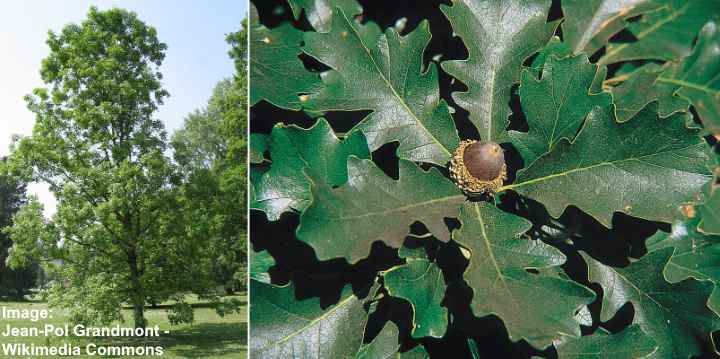
Bur oak tree, leaves and acorn
The bur oak is a huge deciduous oak tree native to North and Central Texas. Identifying features of the bur oak are its large dark green leaves with five to seven deep lobes almost to the central vein and large oval brown acorns in a fringed cup.
The bur oak tree has a large, open crown providing dappled shade in hot Texan landscapes. The oak tree grows 60 to 80 ft. (18 – 24 m) tall and wide. The native Texas tree is suitable for growing in USDA zones 3 to 9 and in full sun.
The acorns of the bur oak tree measure 1.5” (3.8 cm) long and are easily recognizable due to their deeply fringed cap.
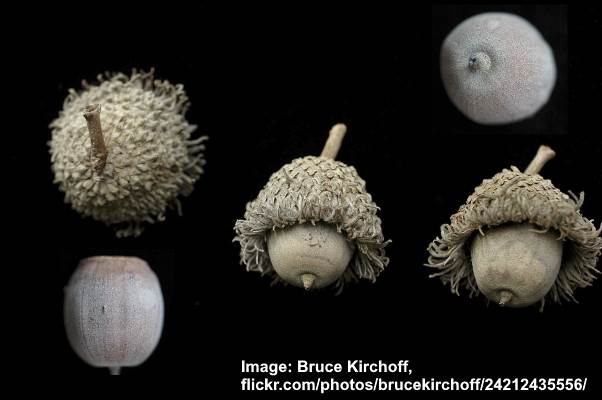
Bur oak acorn s
Texas oak tree leaves: The leaves of the bur oak measure 6” to 12” (15 – 30 cm) long with deeply rounded lobes. The green foliage turns coppery-brown or golden-yellow in the fall.
Texas oak tree bark: Bur oak bark is an unusual light brown to gray color that develops deep furrows as the tree matures.
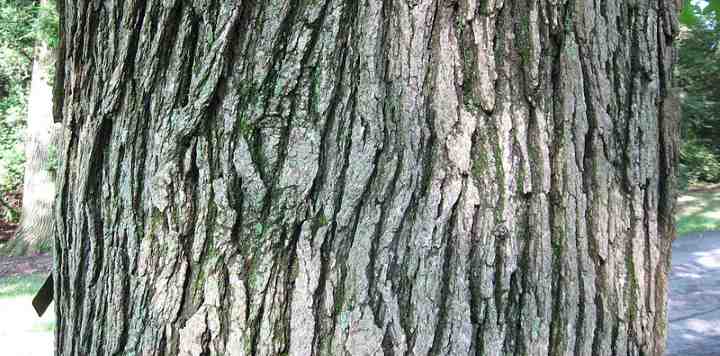
Bur Oak (Quercus macrocarpa)
Mexican Blue Oak Tree (Quercus oblongifolia)
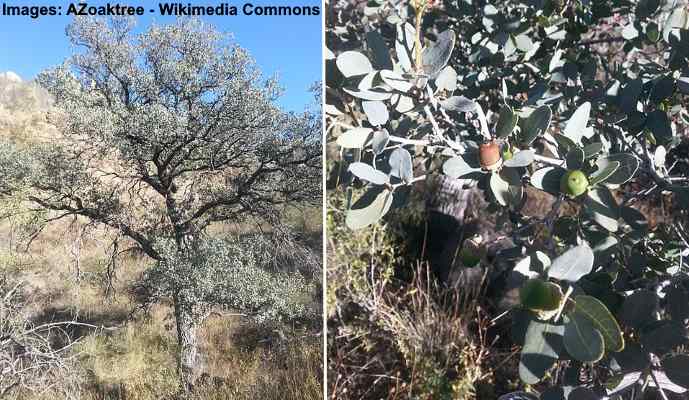
Mexican blue oak (Quercus oblongifolia) tree, leaves and acorns
The Mexican blue oak is a small evergreen oak tree that grows in the deserts in Texas, New Mexico, and Arizona. The shrub-like oak tree has bluish-green oblong leaves, brown egg-shaped acorns in scaly caps that cover about one third the length of the nut, and yellowish flowers. The Mexican blue oaks grow 16 to 27 ft. (5 – 8 m) tall.
Texas oak tree leaves: The Mexican blue oak leaves are glossy on the top with a woolly underside. The evergreen elliptical silvery-gray leaves measure up to 4” (10 cm) long and have smooth margins.
Texas oak tree bark: The Mexican blue oak bark is scaly light brown-gray and densely furrowed when the tree matures.
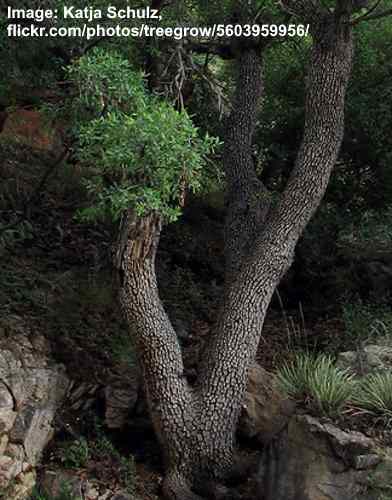
Mexican blue oak bark
Blackjack Oak Tree (Quercus marilandica)
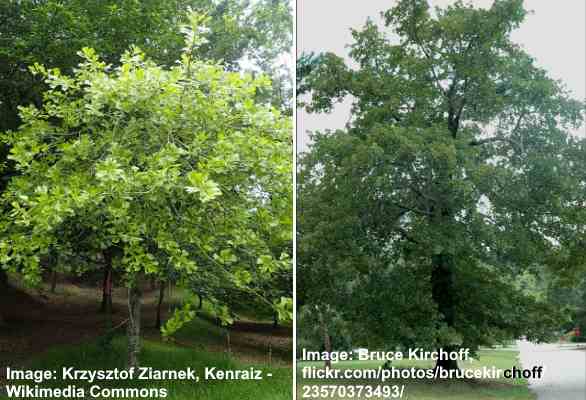
Blackjack oak (Quercus marilandica) young and mature trees
The blackjack oak is a small to medium-sized red oak species native to Central Texas. The oak tree is identified by its three bristle-tipped lobes, small light brown acorns, and dark gray bark that develops into square plates. This Texas oak grows in poor, sandy soils where other oak trees cannot grow.
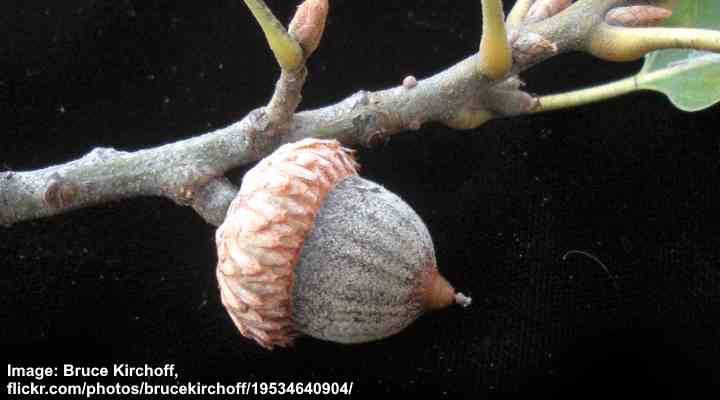
Blackjack oak acorn
The blackjack oak is suitable for growing in all regions of Texas in USDA zones 6 to 9. It grows up to 50 ft. (15 m) tall.
Texas oak tree leaves: Blackjack oak tree leaves have a glossy, leathery feel and are the widest at the apex. The leaves measure 3” to 8” (7 – 20 cm) long and have three to five lobes. Its fall color is pale brown to russet.

Blackjack oak leaves
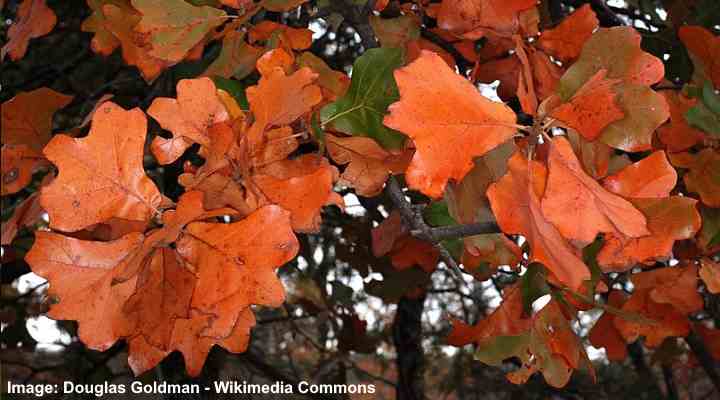
Blackjack oak leaves in autumn
Texas oak tree bark: Blackjack oak tree has dark brown to black rough bark on mature trees with rectangular plates.
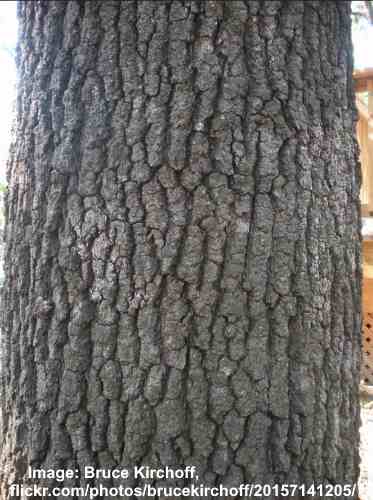
Blackjack oak bark
Water Oak Tree (Quercus nigra)
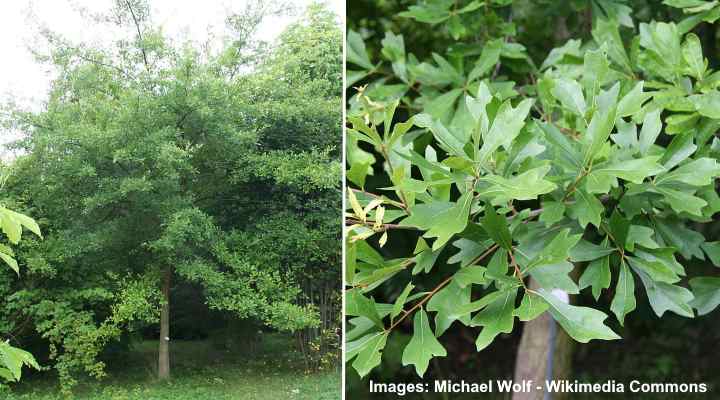
Water oak (Quercus nigra) tree and leaves
The water oak is a medium to large deciduous oak tree with a fast-growth habit. The oak tree is recognized by its broad, rounded crown consisting of obovate, pear-shaped leaves, small rounded acorns, and light reddish-brown to gray bark. The water oak grows 50 to 80 ft. (15 – 24 m) tall in ideal conditions.
As its name suggests, the water oak tree grows alongside streams and on the borders of swamps throughout the Lone Star State. It is suitable for growing in USDA zones 6 to 9
Texas oak tree leaves: The leaves of the water oak tree are spatula-shaped with shallow three lobes near the wide apex. The leaves measure 1.2” to 4.7” (3 – 12 cm) long and up to 2.3” (6 cm) at the widest point. They persist on the tree until midwinter in Texas.
Texas oak tree bark: Water oak has smooth bark that becomes rough and scaly and almost black as the oak matures.

Water oak tree bark
Willow Oak (Quercus phellos)
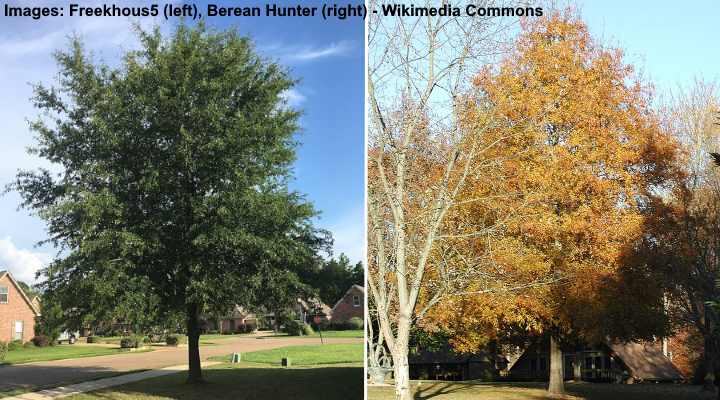
Willow oak trees (Quercus phellos). Right picture: Willow oak in autumn
The willow oak gets its name from the slender, linear, lanceolate leaves that look like willow tree leaves. In addition, this tall oak tree has an open rounded crown, making it ideal as a shade tree in parks and lawns. Identifying features of the tree are its small dark brown acorns sitting in shallow, saucer-like caps cups and smooth, reddish-brown bark.
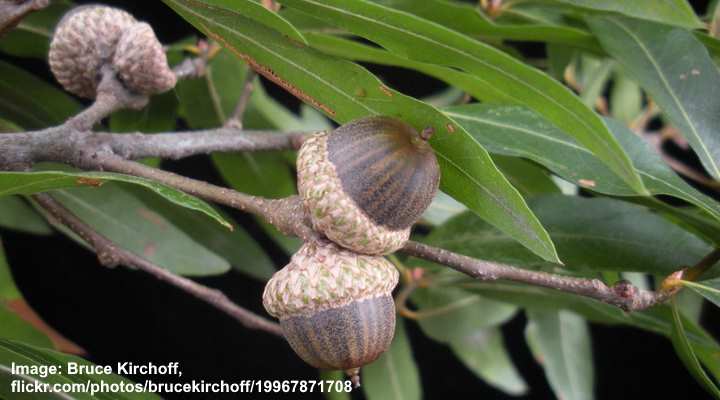
Willow oak tree acorns
The willow oak tree grows 40 to 60 ft. (12 – 18 m) with bright green summer colors that turn yellow, orange, or russet in the fall.
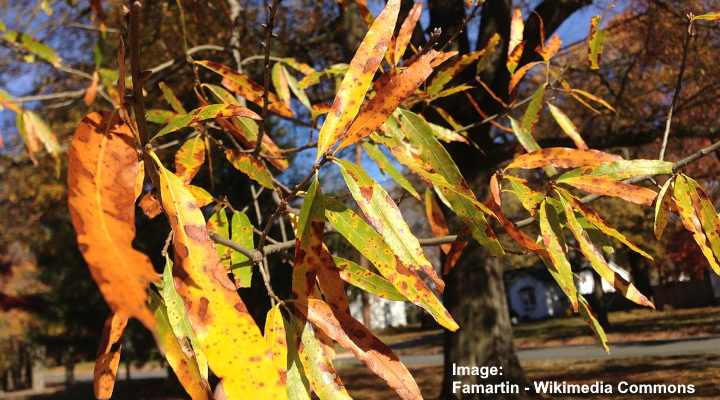
Willow oak leaves in autumn
The willow oak is classified as monoecious, meaning that male and female flowers bloom on the same tree. Male willow oak flowers are pendulous yellow catkins (flowering spikes) that grow 2” to 3” (5 – 7.5 cm) long. Willow oak female flowers are small spikes growing in groups of two or three.
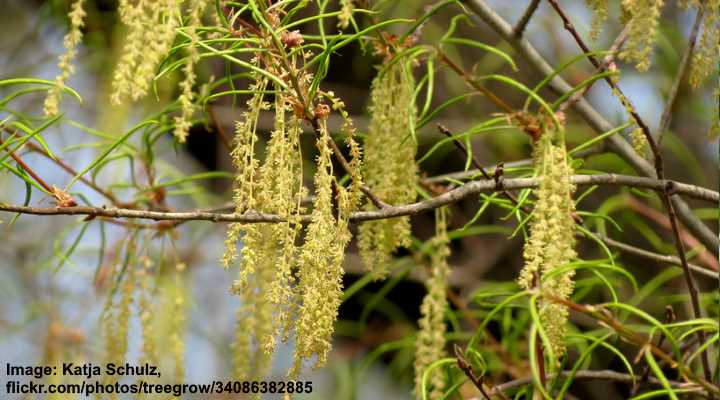
Willow oak male flowers (catkins)
Texas oak tree leaves: Willow oak tree leaves are lance-shaped, slender leaves measuring 5” (13 cm) long and 1” wide. The unusual oak leaves taper to a fine point and lack characteristic lobing.
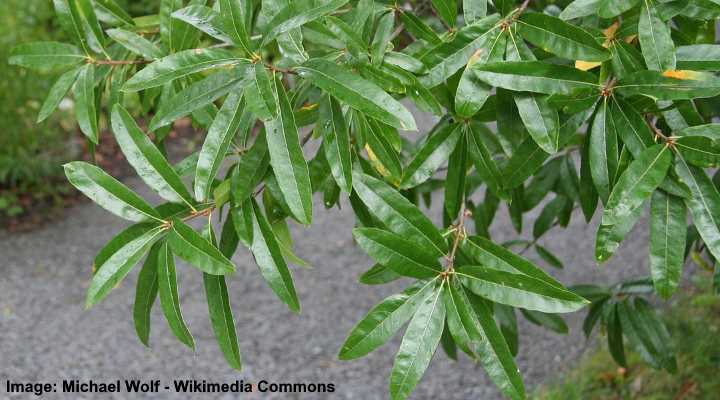
Willow oak tree leaves
Texas oak tree bark: The bark of the willow oak tree is smooth and reddish-brown on immature trees. As the oak tree matures, scaly plates with shallow furrows develop and give the tree’s gray bark a rough texture. In addition, mature willow oaks have deeply furrowed grooves and signs of cracking in the bark.
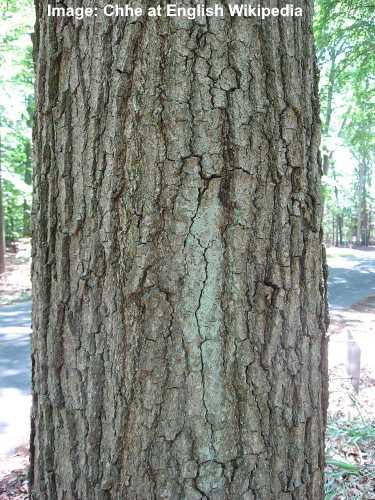
Willow Oak Tree Bark
Overcup Oak Tree (Quercus lyrata)
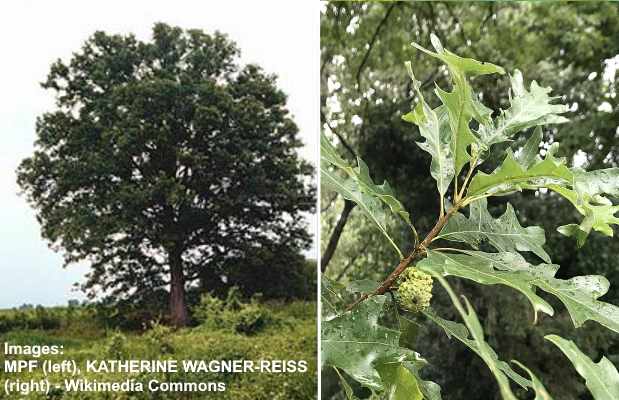
Overcup oak (Quercus lyrata) tree and leaves
The overcup oak is a tall oak tree with a buttressed trunk that grows in wetlands, swamp forests, and damp environments. This native Texas oak tree grows up to 90 ft. (27 m) tall. It is identified by its glossy green leaves with five to nine lobes, no bristle tips, flattened, round acorns, and light gray bark.
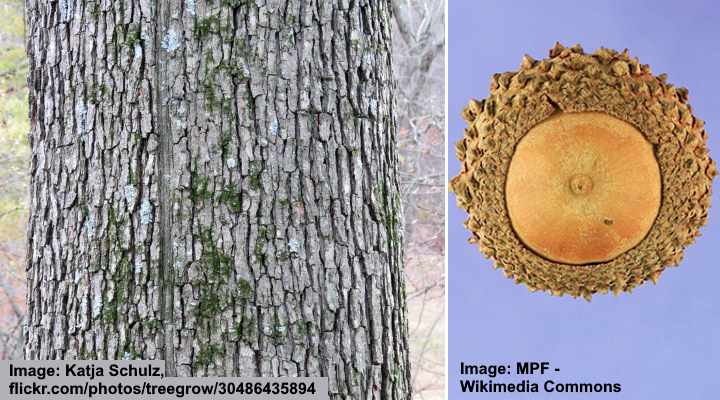
Overcup oak tree bark and acorn
An identifying feature of the oak tree acorns is the caps that almost cover the entire golden-brown nut. The overcup oak trees are common in Central and Eastern Texas.
Texas oak tree leaves: Overcup oak tree leaves are characteristic oak leaves with distinctive curved and rounded lobes along the margins. The leaves measure 6” to 20” (15 – 50 cm) long and up to 4” (10 cm) wide.
Texas oak tree bark: Overcup oak tree bark is identified as gray with furrowed ridges forming irregular patterns of scaly ridges up the trunk.
Common White Oak (Quercus alba)
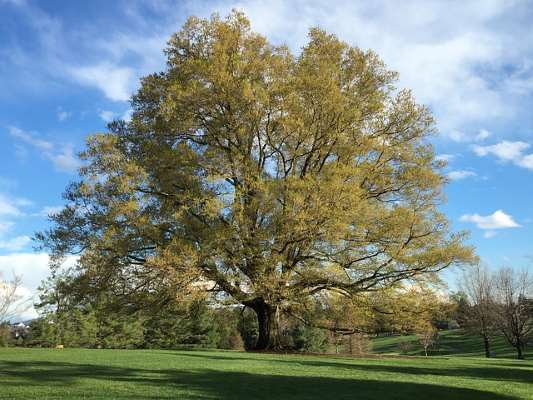
White oak tree (Quercus alba)
The common white oak tree typically thrives in Eastern Texas. It is identified by its short trunk and tall, pyramidal crown. The drought-tolerant oak tree has characteristic oak leaves with several rounded lobes, rich brown oval acorns, and ash-gray bark that has a scaly, shaggy appearance.
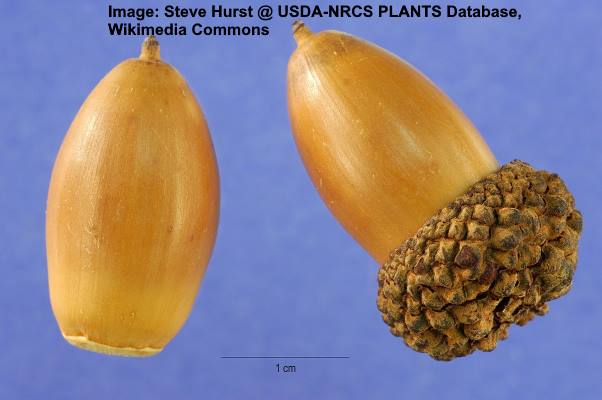
White oak acorns
Also called the American oak tree, the majestic landscape tree grows 50 to 80 ft. (15 – 24 m) tall and wide. It is suitable for USDA zones 3 to 9 and is perfect as a shade or lawn tree.
Flowers on the white oak tree are clusters of small dangling yellowish-green flowers or red spikes. White oak is a monoecious tree, producing male and female flowers. The male flowers are pendulous pale greenish catkins, whereas the female flowers are small red spikes. Typically, oak tree flowers are insignificant.
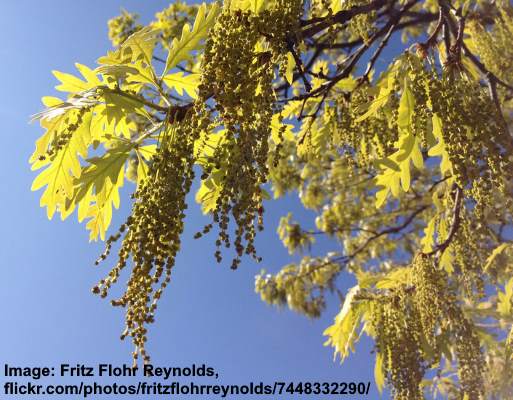
White oak male flowers
Texas oak tree leaves: White oak tree leaves are dark green elliptical shaped with five to nine finger-like lobes. The leaves grow 4” to 9” (10 – 22 cm) long and up to 4 (10 cm) wide. The oak’s fall colors are red to burgundy or golden brown.

White oak tree leaves
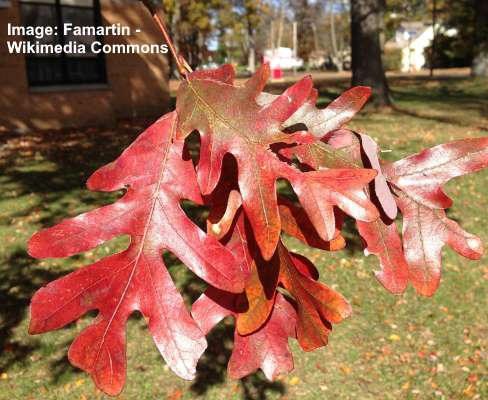
White oak leaves in autumn
Texas oak tree bark: Bark on the white oak tree trunk is light gray with a shallowly furrowed texture and narrow plates. As the white oak matures, bark can start to peel.
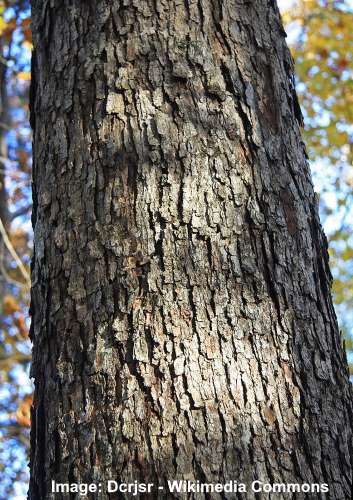
White oak bark
Graves Oak Tree (Quercus gravesii)
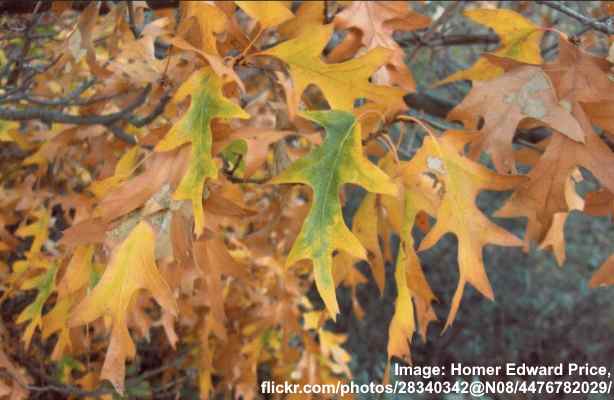
Graves oak (Quercus gravesii) leaves in autumn
Graves oak is a stout, medium-sized oak tree that grows 40 ft. (12 m) tall. The Texas oak is native to the western regions of the state and is common in the Chisos mountains. Identifying features of the ornamental tree are its bristle-tipped lobed leaves, stumpy round acorns, and dark gray to black fissured bark.
Also called the Chisos red oak, the small oak is an urban-friendly oak tree suitable for garden landscapes. The hardy tree is tolerant of drought and withstands short spells of monsoon rainfall.
Texas oak tree leaves: Graves oak tree leaves measure 3” to 5” (7.6 – 13 cm) long and 3.5” (9 cm) wide. The leaves have three to seven lobes, each with bristle tips. The glossy green foliage turns golden brown in late fall.
Texas oak tree bark: Bark on Graves oak tree is dark gray to black with ridges and narrow fissures.
Swamp Chestnut Oak Tree (Quercus michauxii)
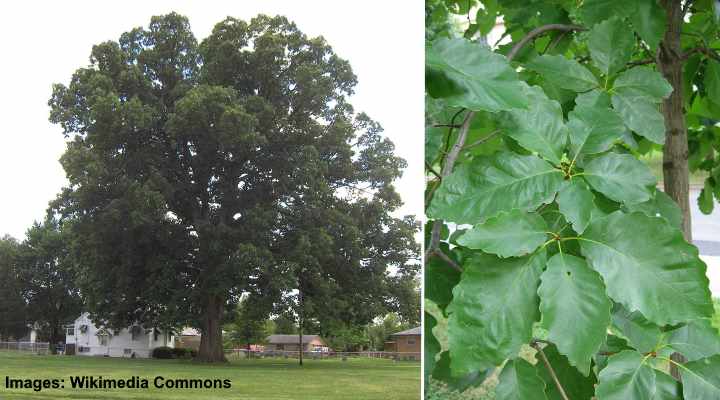
Swamp chestnut oak (Quercus michauxii) tree and leaves
The swamp chestnut oak is a variety of white oak tree that thrives throughout Texas. This oak tree is identified by its broad ovate leaves with toothed margins, similar to a chestnut tree. It has large coppery-brown acorns 1” to 1.5” (2.5 – 3.8 cm) long and has light gray bark with deep V-shaped furrows.
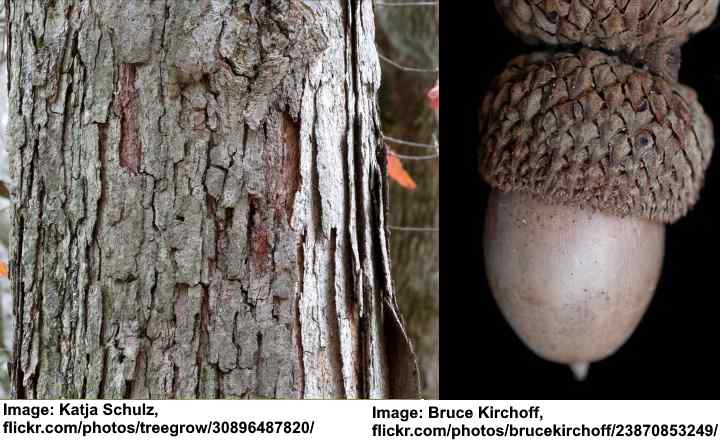
Swamp chestnut oak tree bark and acorn
The swamp chestnut tree grows 60 to 80 ft. (18 – 24 m) tall and 30 to 70 ft. (10 – 21 m) wide. It has a pyramidal, rounded habit.
Texas oak tree leaves: The swamp chestnut oak tree leaves grow up to 9” (22 cm) long and have serrated margins. Its fall colors are orange-brown, orange-yellow, and dark red.
Texas oak tree bark: The bark on swamp chestnut oak is light to medium gray with flaky ridges and deep furrows.
Southern Red Oak Tree (Quercus falcata)
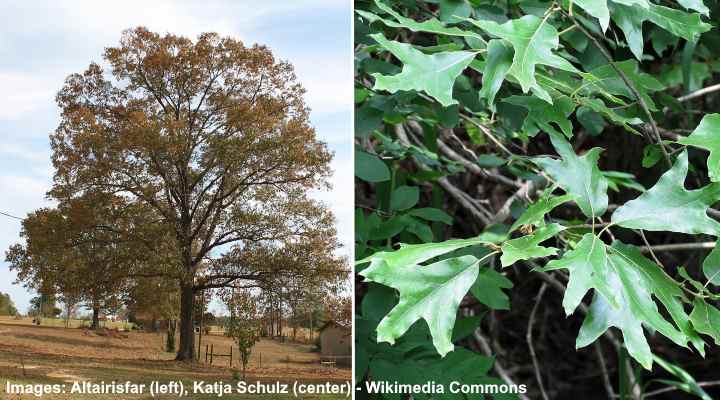
Southern red oak (Quercus falcata) tree and leaves
The southern red oak is a tall deciduous oak tree common throughout Texas. Identifying features of the native Texas oak are its distinctive leaves with three to five bristle-tipped lobes, globular acorns, and dark gray, rough bark. The southern red oak can grow up to 100 ft. (30 m) tall.
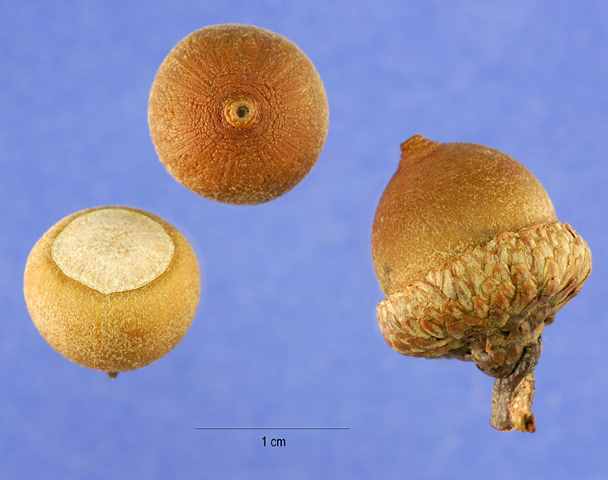
Southern red oak acorns
Texas oak tree leaves: The southern red oak tree leaves measure 5” to 10” (13 – 25 cm) long and 5” (13 cm) wide. These have irregular, pointed lobes with U-shaped bases.

Southern red oak leaf and bark
Texas oak tree bark: Southern red oak tree bark is dark gray to black with vertical ridges and fissures creating irregular patterns.
Shumard Oak Tree (Quercus shumardii)
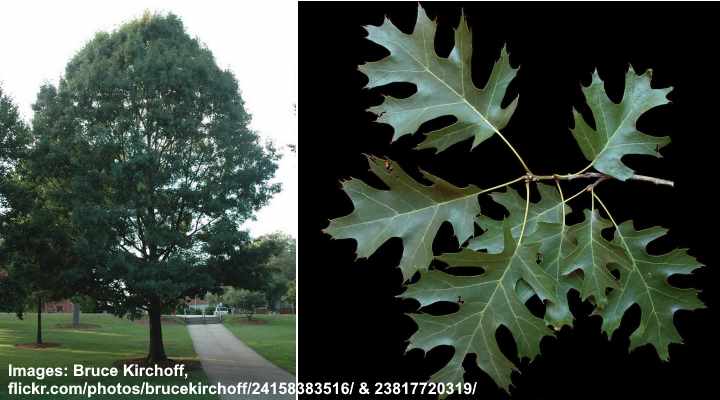
Shumard oak (Quercus shumardii) tree and leaves
The Shumard oak tree is a beautiful shade tree that grows in the eastern Texas. Shumard oaks have an attractive pyramidal crown, bristle-tipped lobed leaves, and a substantial crown. A feature of Shumard oaks is that they have the largest acorns of all the oaks —light to dark-brown acorns measuring up to 1.5” (3.8 cm) wide.
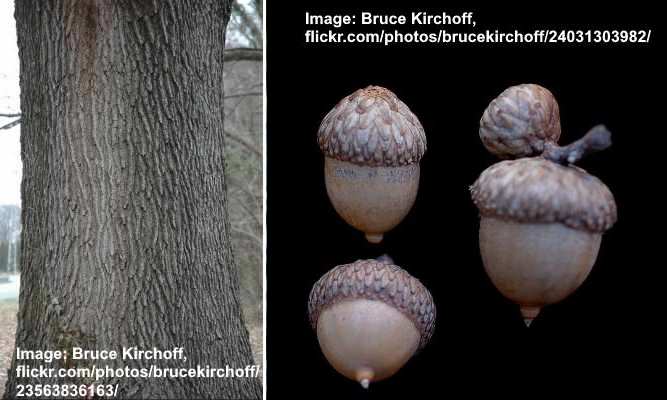
Shumard oak bark and acorns
These oaks grow 50 to 70 ft. (15 – 21 m) tall and up to 40 ft. (12 m) wide.
Texas oak tree leaves: Shumard oak tree leaves are dark green and have a jagged appearance due to their deep, spiny lobes. The oak leaves measure 6” to 8” (15 – 20 cm) long and turn a spectacular red in the fall.Texas oak tree bark: Shumard oak tree bark is dark gray to reddish-brown that develops thick, flat, scaly ridges with shallow grooves as it matures.
Shumard oak is one of the fastest growing trees in Texas.
Related articles:
